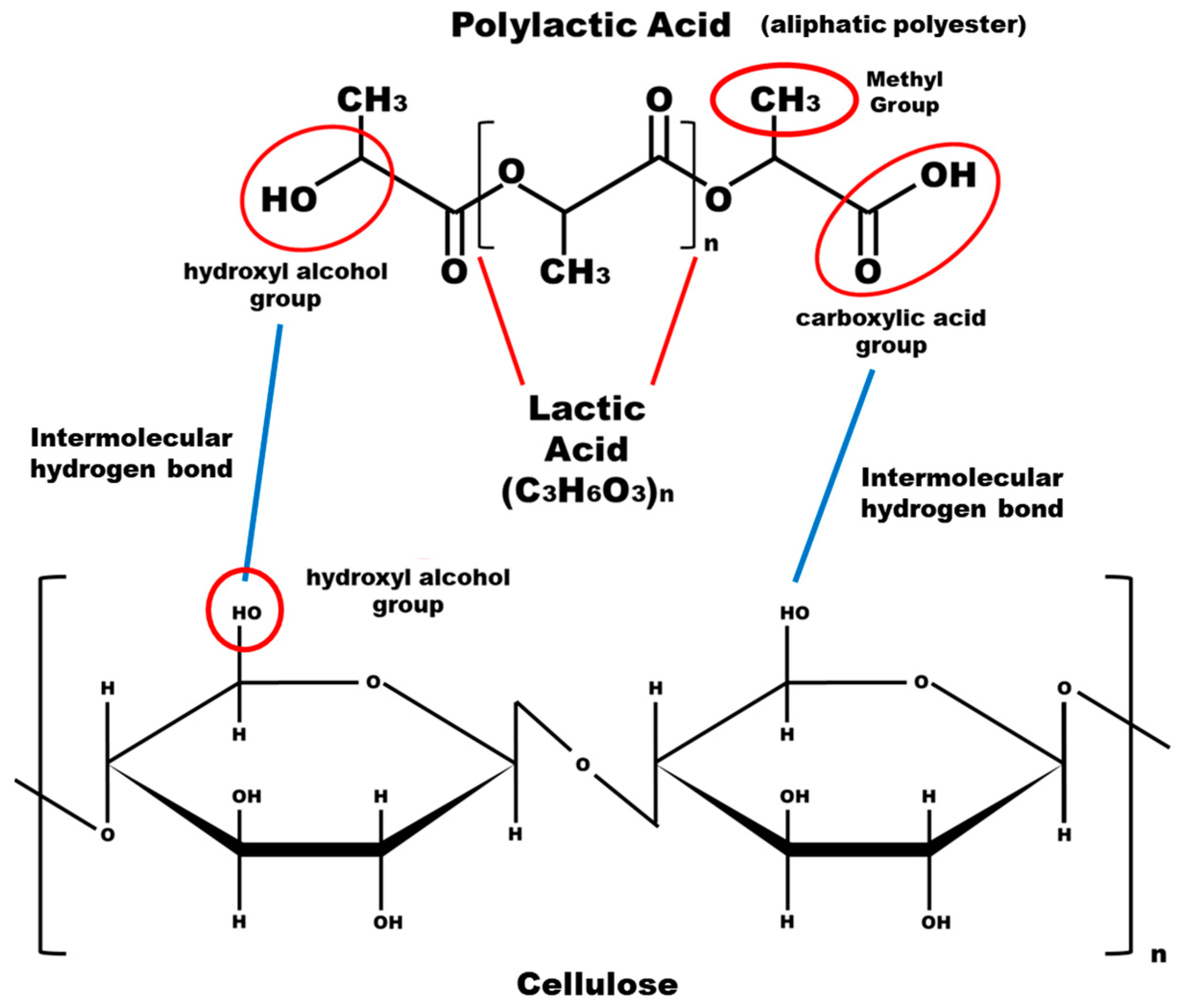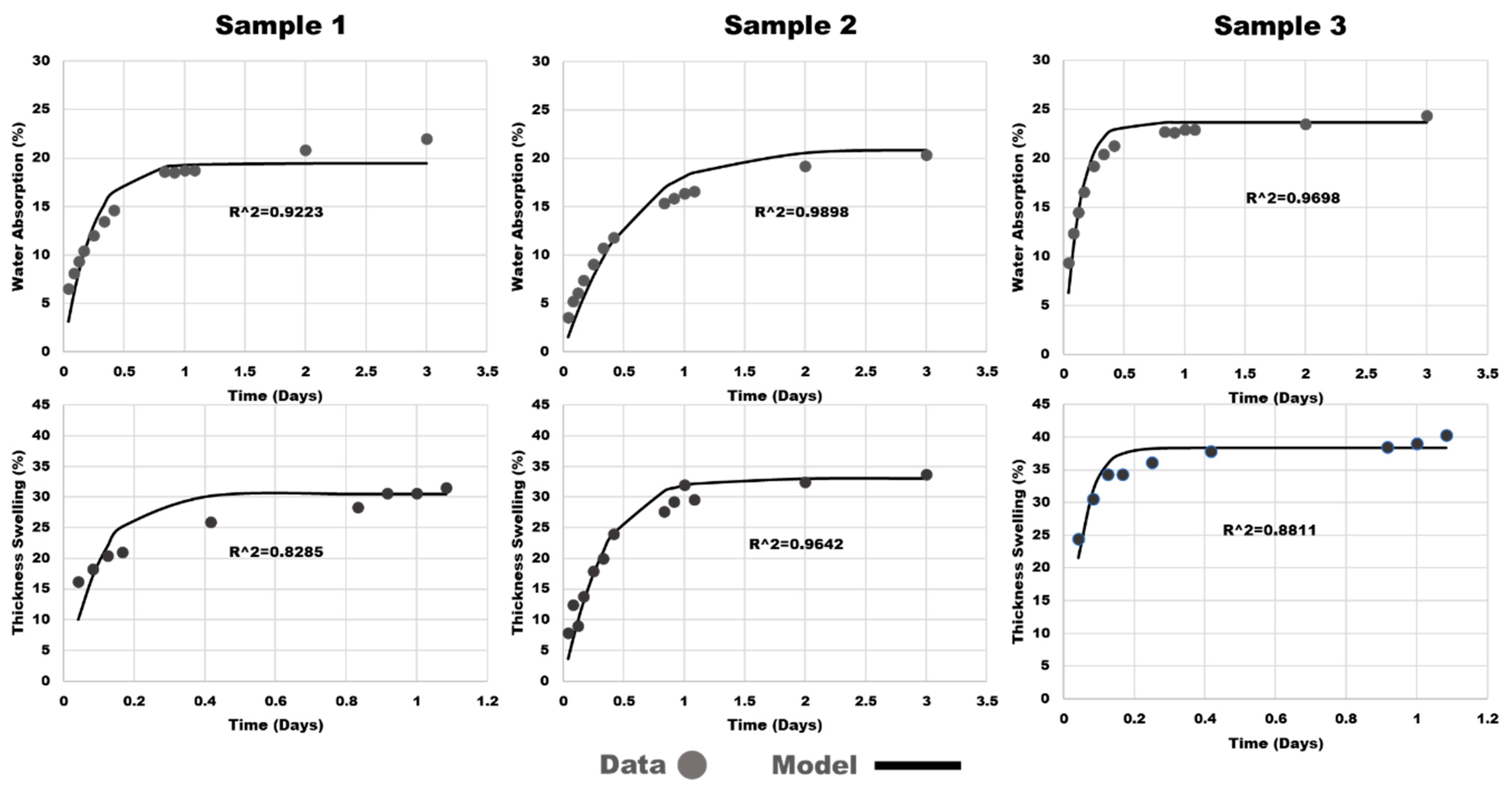Bacterial-Retted Hemp Fiber/PLA Composites
Abstract
1. Introduction
2. Materials and Methods
2.1. Hemp Mat Forming
2.2. PLA Sheet Forming
2.3. BFM/PLA Panel Hot Pressing
2.4. Property Testing
2.5. Water Absorption (WA) and Thickness Swell (TS) Testing
2.6. Differential Scanning Calorimetry (DSC)
2.7. Dynamic Mechanical Analysis (DMA)
3. Results and Discussion
3.1. Mechanical Properties
3.2. Hygroscopic Properties
3.3. DSC Analysis
3.4. DMA
4. Conclusions
Author Contributions
Funding
Data Availability Statement
Conflicts of Interest
References
- Zimniewska, M. Hemp fibre properties and processing target textile: A review. Materials 2022, 15, 1901. [Google Scholar] [CrossRef]
- Gholampour, A.; Ozbakkaloglu, T. A review of natural fiber composites: Properties, modification and processing techniques, characterization, applications. J. Mater. Sci. 2020, 55, 829–892. [Google Scholar]
- Lee, C.H.; Khalina, A.; Lee, S.; Liu, M. A Comprehensive Review on Bast Fibre Retting Process for Optimal Performance in Fibre-Reinforced Polymer Composites. Adv. Mater. Sci. Eng. 2020, 2020, 6074063. [Google Scholar]
- Fu, Y.; Zhang, Y.; Allen, M.S.; Shi, S.Q. Effects of Pectinase on Bacterial Succession during Hemp Retting. Processes 2024, 12, 1725. [Google Scholar] [CrossRef]
- Fu, Y.; Gu, H.; Wu, F.; Shi, S.Q. Comparative Life Cycle Assessment of Bacterial and Thermochemical Retting of Hemp. Materials 2024, 17, 4164. [Google Scholar] [CrossRef]
- Naser, A.Z.; Deiab, I.; Darras, B.M. Poly (lactic acid)(PLA) and polyhydroxyalkanoates (PHAs), green alternatives to petroleum-based plastics: A review. RSC Adv. 2021, 11, 17151–17196. [Google Scholar] [PubMed]
- Niaounakis, M. Biopolymers: Processing and Products; William Andrew: Norwich, NY, USA, 2014. [Google Scholar]
- Ioelovich, M. Adjustment of hydrophobic properties of cellulose materials. Polymers 2021, 13, 1241. [Google Scholar] [CrossRef]
- Ren, Z.; Guo, R.; Bi, H.; Jia, X.; Xu, M.; Cai, L. Interfacial adhesion of polylactic acid on cellulose surface: A molecular dynamics study. ACS Appl. Mater. Interfaces 2019, 12, 3236–3244. [Google Scholar]
- Sawpan, M.A.; Pickering, K.L.; Fernyhough, A. Improvement of mechanical performance of industrial hemp fibre reinforced polylactide biocomposites. Compos. Part A Appl. Sci. Manuf. 2011, 42, 310–319. [Google Scholar] [CrossRef]
- Shakoor, A.; Muhammad, R.; Thomas, N.L.; Silberschmidt, V.V. Mechanical and thermal characterisation of poly (l-lactide) composites reinforced with hemp fibres. J. Phys. Conf. Ser. 2013, 451, 012010. [Google Scholar]
- Masirek, R.; Kulinski, Z.; Chionna, D.; Piorkowska, E.; Pracella, M. Composites of poly (L-lactide) with hemp fibers: Morphology and thermal and mechanical properties. J. Appl. Polym. Sci. 2007, 105, 255–268. [Google Scholar] [CrossRef]
- Behalek, L.; Seidl, M.; Dobransky, J. Crystallization of Polylactic Acid Composites with Banana and Hemp Fibres by Means of DSC and XRD Methods. Appl. Mech. Mater. 2014, 616, 325. [Google Scholar]
- Antony, S.; Cherouat, A.; Montay, G. Fabrication and characterization of hemp fibre based 3D printed honeycomb sandwich structure by FDM process. Appl. Compos. Mater. 2020, 27, 935–953. [Google Scholar] [CrossRef]
- ASTM D3039/D3039M-00; Standard Test Method for Tensile Properties of Polymer Matrix Composite Materials. ASTM International: West Conshohocken, PA, USA, 2000.
- ASTM D7264/D7264M-15; Standard Test Method for Flexural Properties of Polymer Matrix Composite Materials. American Society of Testing Materials: West Conshohocken, PA, USA, 2015.
- ASTM D1037-12; Standard Test Methods for Evaluating Properties of Wood-Base Fiber and Particle Panel Materials. American Society for Testing and Materials: West Conshohocken, PA, USA, 2020. [CrossRef]
- Shi, S.Q.; Gardner, D.J. Hygroscopic thickness swelling rate of compression molded wood fiberboard and wood fiber/polymer composites. Compos. Part A Appl. Sci. Manuf. 2006, 37, 1276–1285. [Google Scholar]
- Stelea, L.; Filip, I.; Lisa, G.; Ichim, M.; Drobotă, M.; Sava, C.; Mureșan, A. Characterisation of Hemp Fibres Reinforced Composites Using Thermoplastic Polymers as Matrices. Polymers 2022, 14, 481. [Google Scholar] [CrossRef] [PubMed]
- Gupta, M.K.; Singh, R. Flexural and dynamic mechanical analysis (DMA) of polylactic acid (PLA) coated sisal fibre reinforced polyester composite. Mater. Today Proc. 2018, 5, 6109–6114. [Google Scholar]
- Matweb. Overview of Materials for Epoxy, Molded, Glass Fiber Filler. Available online: https://www.matweb.com/search/datasheet.aspx?matguid=035d2130b7f34d918e8d590659b85cb7&ckck=1 (accessed on 28 August 2024).
- Baghaei, B.; Skrifvars, M.; Rissanen, M.; Ramamoorthy, S.K. Mechanical and thermal characterization of compression moulded polylactic acid natural fiber composites reinforced with hemp and lyocell fibers. J. Appl. Polym. Sci. 2014, 131, 40534. [Google Scholar]
- Celik, E.; Uysal, M.; Gumus, O.Y.; Tasdemir, C. 3D-Printed Biocomposites from Hemp Fibers Reinforced Polylactic Acid: Thermal, Morphology, and Mechanical Performance. BioResources 2025, 20, 331–356. [Google Scholar]
- Cristea, M.; Ionita, D.; Iftime, M.M. Dynamic mechanical analysis investigations of PLA-based renewable materials: How are they useful? Materials 2020, 13, 5302. [Google Scholar] [CrossRef]
- Yang, S.L.; Wu, Z.H.; Yang, W.; Yang, M.B. Thermal and mechanical properties of chemical crosslinked polylactide (PLA). Polym. Test. 2008, 27, 957–963. [Google Scholar] [CrossRef]
- Chen, C.C.; Chueh, J.Y.; Tseng, H.; Huang, H.M.; Lee, S.Y. Preparation and characterization of biodegradable PLA polymeric blends. Biomaterials 2003, 24, 1167–1173. [Google Scholar] [CrossRef] [PubMed]







| Samples | Initial Ratios | Final Ratios | PLA Mass Loss | Density | ||
|---|---|---|---|---|---|---|
| (%) | (%) | (%) | g/cm3 | |||
| BFM | PLA | BFM | PLA | |||
| 1 (BFM/PLA 53/47) | 52.9 | 47.2 | 54.1 | 45.9 | 2.3 | 1.23 |
| 2 (BFM/PLA 43/57) | 42.5 | 57.5 | 50.5 | 49.5 | 14.4 | 1.30 |
| 3 (BFM/PLA 35/65) | 35.2 | 64.8 | 48.1 | 51.9 | 26.8 | 1.26 |
| Absorption Parameters | Swelling Parameters | |||
|---|---|---|---|---|
| Sample | Kar | R2 | Ksr | R2 |
| 1 (BFM/PLA 53/47) | 4.92 | 0.92 | 11.84 | 0.83 |
| 2 (BFM/PLA 43/57) | 2.17 | 0.99 | 3.65 | 0.96 |
| 3 (BFM/PLA 35/65) | 8.79 | 0.97 | 24.56 | 0.88 |
| Sample | Tg (°C) | Tc (°C) | Tm (°C) |
|---|---|---|---|
| PLA | 63.56 | 111.46 | 150.83 |
| 1 (BFM/PLA 53/47) | 65.32 | 106.08 | 158.27 |
| 2 (BFM/PLA 43/57) | 65.43 | 110.90 | 156.14 |
| 3 (BFM/PLA 35/65) | 65.00 | 103.07 | 157.43 |
| Sample | Tg at Tan δ Peak (°C) | Tan δ Peak | Storage Modulus at 23 °C |
|---|---|---|---|
| PLA | 62.46 | 2.5218 | 2714 |
| 1 (BFM/PLA 53/47) | 63.79 | 0.2160 | 6216 |
| 2 (BFM/PLA 43/57) | 64.16 | 0.1493 | 7967 |
| 3 (BFM/PLA 35/65) | 68.06 | 0.1353 | 7876 |
Disclaimer/Publisher’s Note: The statements, opinions and data contained in all publications are solely those of the individual author(s) and contributor(s) and not of MDPI and/or the editor(s). MDPI and/or the editor(s) disclaim responsibility for any injury to people or property resulting from any ideas, methods, instructions or products referred to in the content. |
© 2025 by the authors. Licensee MDPI, Basel, Switzerland. This article is an open access article distributed under the terms and conditions of the Creative Commons Attribution (CC BY) license (https://creativecommons.org/licenses/by/4.0/).
Share and Cite
Smith, L.M.; Fu, Y.; Pittala, R.K.; Wang, X.; Jabel, C.; Masignag, K.; Arellanes, J.; Ghosh, M.; Shi, S.Q.; Ecker, M.; et al. Bacterial-Retted Hemp Fiber/PLA Composites. Processes 2025, 13, 1000. https://doi.org/10.3390/pr13041000
Smith LM, Fu Y, Pittala RK, Wang X, Jabel C, Masignag K, Arellanes J, Ghosh M, Shi SQ, Ecker M, et al. Bacterial-Retted Hemp Fiber/PLA Composites. Processes. 2025; 13(4):1000. https://doi.org/10.3390/pr13041000
Chicago/Turabian StyleSmith, Lee M., Yu Fu, Raj Kumar Pittala, Xun Wang, Chloe Jabel, Kelvin Masignag, Josue Arellanes, Mahan Ghosh, Sheldon Q. Shi, Melanie Ecker, and et al. 2025. "Bacterial-Retted Hemp Fiber/PLA Composites" Processes 13, no. 4: 1000. https://doi.org/10.3390/pr13041000
APA StyleSmith, L. M., Fu, Y., Pittala, R. K., Wang, X., Jabel, C., Masignag, K., Arellanes, J., Ghosh, M., Shi, S. Q., Ecker, M., & Wang, C. (2025). Bacterial-Retted Hemp Fiber/PLA Composites. Processes, 13(4), 1000. https://doi.org/10.3390/pr13041000










